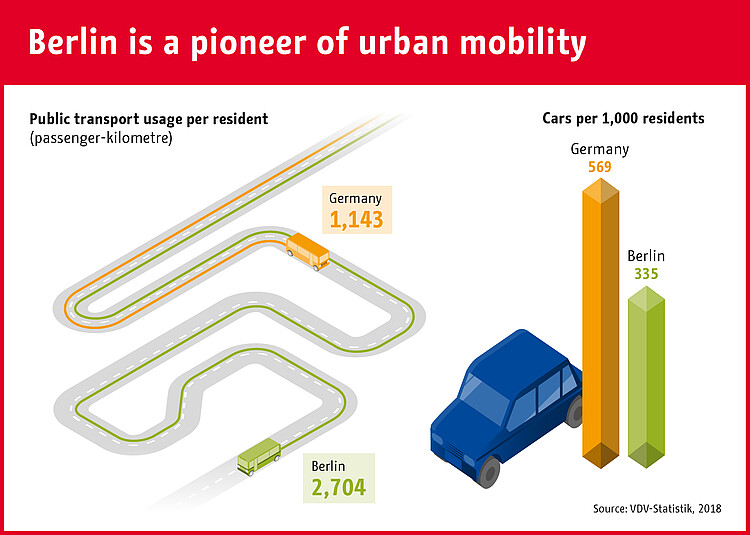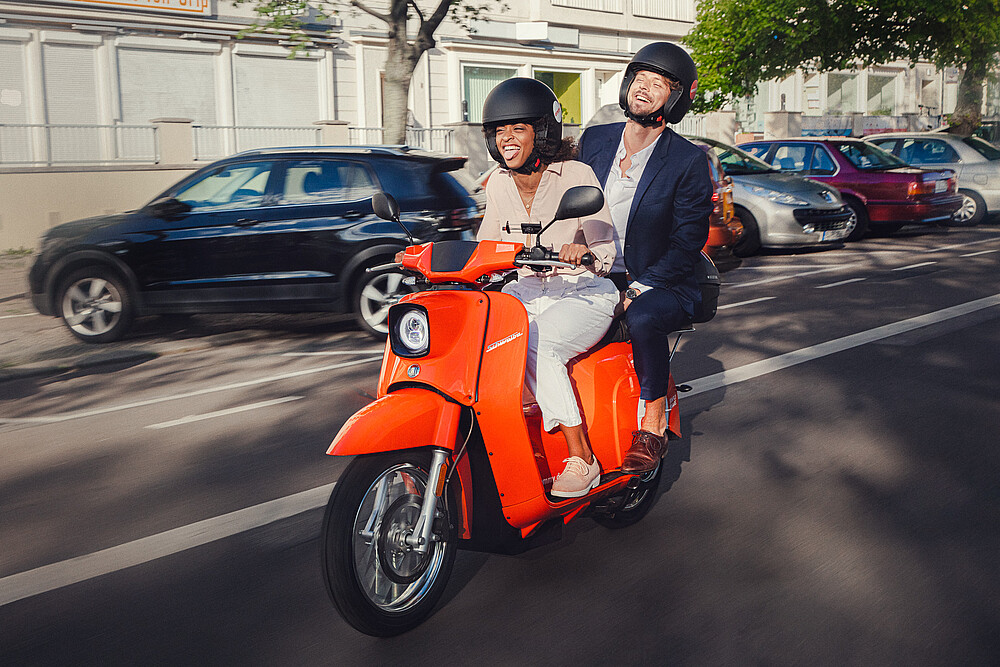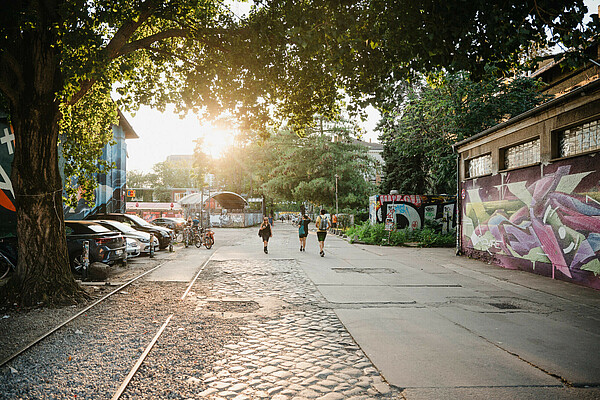How to get around Berlin sustainably
Sharing is caring – a new urban mobility
No matter what time it is, there's always a way to get around Berlin. The public transportation systemis one of the best in the world and will zip you through the city at any hour of the day. This makes it easy for freelancers hopping from company to coworking space, employees commuting to the hottest (but sometimes out-of-the-way) startups, and founders looking to recruit from all corners of the city.
The process of getting from A to B is changing profoundly and the catch-all word for this multifarious wave of the future is mobility. When it comes to mobility Berlin is already on a sustainable track and working to be even more so in the years to come.
Public transport vs. car
Berlin is a pioneer of urban mobility with extensive public transport and low dependence on motorized private transport. The capital has by far the fewest cars per inhabitant in Germany. At the same time, residents of Berlin annually travel the greatest distances by bus and train: Metro trains travel a combined total of over 2.5 billion kilometres per year.

Berlin's efficient public transport system operated by Berliner Verkerhsbetriebe (BVG) and Deutsche Bahn comprises the U-Bahn (underground, or subway), the S-Bahn (light 'city' rail), buses, and trams. The U-Bahn is usually the most efficient way of getting around the inner ring and the S-Bahn comes in handy for covering longer distances, while buses, trams, and bicycles are useful for shorter journeys. TripSavy provides a guide to Berlin's public transportation system, featuring all the important lines as well as information regarding tickets.
Given all of these options and good bike paths in most parts of the city, most Berliners don't own a car, and most visitors don't need one. But for trips away from the city centre, a set of wheels can be very handy and, apart from the traditional car rental companies, there are now several ride-sharing platforms available as well as various sharing options for bikes and scooters.
Are you in the mobility business and developing new solutions for future transport? Berlin Partner helps create networks and develop projects in transport, mobility and logistics in the capital region. Reach out or check for upcoming events!
Berlin’s sustainable mobile infrastructure
Already ranked 3rd globally for sustainability in 2017 by Arcadis, Berlin is paving the way for a new balance between cars, bicycles, public transport, and pedestrians with its Mobility Act. The main goal is to create a liveable city and improve the mobility infrastructure in order to ensure all road users will be able to travel safely. The act aims to improve the efficiency of the transport system as a whole and supports the goal of the Berlin Senate to make car traffic in Berlin climate-neutral by 2050.
“Berlin plans to become safer, more mobile, and more climate-friendly. In a growing metropolis like Berlin, this can only succeed if the strengths of all forms of mobility - bus, rail, bicycle, car, pedestrian traffic - are taken into consideration” - Senate Department.
One of the key concepts of the act is to improve cycling infrastructure and conditions in Berlin. Several projects to create a more comprehensive network of bicycle lanes are currently in the works. Service provider Infravelo, for example, plans to visibly improve the situation for cyclists with color-coded cycle paths, improved signage, and safe bicycle stands. They are also planning so called rapid-cycle connections to ensure comfortable rides over longer distances of up to ten kilometres. Meanwhile, Radbahn intends to transform the somewhat forlorn space along Berlin’s famous U1 elevated subway line into a major urban thoroughfare and create a zone for contemporary mobility, innovation, and leisure.

Car, bike and e-scooter sharing options
If you want to go somewhere in Berlin without relying on public transport or driving your own car, all you have to do is download one of the many sharing mobility apps.
A recent study compares the many different mobility options German cities offer - from public transport, car and scooter sharing, e-scooters and rental bikes to ride sharing and cab services. Unsurprisingly, Berlin takes first place.

The most popular kind of car-sharing in Germany is free-floating. Car2Go and DriveNow, now under one umbrella as ShareNow, are good examples. The Smart, Mercedes-Benz, BMW and MINI cars can be rented spontaneously or pre-booked; others require pickup and dropoff at fixed locations.
Also trending are ride-pooling services such as BerlKönig and Clever Shuttle. Within the inner Berlin area these pick up services collect passengers with small busses or vans and drive them to their destinations. This offers a very comfortable way of getting around central Berlin, can be up to 50% cheaper compared to a taxi and reduces overall traffic.
Another easy to use and cheap option is to rent a pedal bike from various suppliers. For bicycles try Wheels, Nextbike, LimeBike, Jump, or Donkey Republic.
And of course there are e-scooters available wherever you are. Berlin-based micro-mobility firm TIER started in 2018, has so far raised $660 million in funding and is operating an ever growing fleet of e-scooters, e-bikes, and e-mopeds in 135+ cities across 15 countries, and also a network of battery charging stations. Other sharing operators in Berlin include Lime, Voi, Bird, Tier, Circ, and emmy with its iconic Schwalbe (swallow), an electrified version of a motor scooter that was popular in the GDR.

Spoilt for choice between intelligent mobility solutions
The easiest way to flexibly choose between the different options is to download the Jelbi app, which provides access to all services available in Berlin. Based on real-time traffic information, the journey planner shows you all the ways available to get to your destination and compares them clearly by duration and price, so that you can book just what you need for the occasion, weather conditions, price, or simply your mood.
As a center for smart mobility, the Berlin Agency for Electromobility supports economic development in the sector, helps companies to build substantial partnerships and provides information about funding opportunities.
Header image: © Eyem






